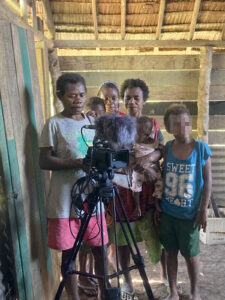The Simbali Baining of Papua New Guinea: A community-based documentation project

Landing page image for the collection “The Simbali Baining of Papua New Guinea: A community-based documentation project”. Fidelia Amalgethu explaining the recording equipment to her neighbours Elma and Defna (from left to right) and their children. Click on image to access collection.
| Language | Simbali Baining (ISO639-3:smg) |
| Depositor | Henrike Frye |
| Affiliation | Universität zu Köln |
| Location | Papua New Guinea |
| Collection ID | 0694 |
| Grant ID | IPF0398 |
| Funding Body | ELDP |
| Collection Status | Collection online |
| Landing Page Handle | http://hdl.handle.net/2196/884f9353-ea4c-4686-b83c-18cdb828198z |
Blog post
A Day in the Field – Henrike Frye
Summary of the collection
Simbali is the smallest language within the Baining family, spoken in the southern part of the Gazelle Peninsula. The data to be found here in the future will be collected in a community-based documentation project, funded by ELDP from 2022-2024. The focus is on those genres which the community considers to be most relevant and on speech events concerning ethnobiology. All of them will be recorded both on video and audio.
Group represented
Simbali is spoken in the southern Gazelle Peninsula. Simbali is the smallest and least documented language from the Baining family. To my knowledge, apart from a wordlist of around 250 entries compiled by Tonya Stebbins and a vitality assessment by SIL (Carter et al. 2012), there are no publications on the language available. The wordlist indicates that, while there are clear similarities sometimes to the Qaqet, sometimes to the Mali lexicon, many lexemes are entirely different from the other Baining languages. While all Baining languages show remnants of intense contact with speakers of Austronesian languages, Simbali speakers have additionally lived in close proximity to the Sulka community, speaking another East Papuan language (Stebbins 2009). In 2012 it was reported to be strongest in the villages Alingirka, Avungi and Kavudemki (Carter et al. 2012). The same report describes a strong ethno-linguistic identity and a vivid interest in maintaining the language. Simbali language was classified “vigorous” as in all three villages, children acquired it as a first language (Carter et al. 2012). However, this estimation is not true for today. The speaker group was already extremely small in 2012 and since then, they have lost most of their customary land to palm oil- and logging companies (Hambloch 2018, GlobalWhitness 2021). Loss of traditional life style, which is a direct consequence of land loss, in combination with necessarily increased contact with speakers of other languages, have been identified as main factors of language shift and as a central cause of loss of ethnobiological knowledge throughout PNG (Kik et al. 2021). References: Carter, K.; Carter, J.; Grummitt, J.; Masters, J.; Paris, H.; Paris, B. 2012: Gazelle Peninsula Survey of Kairak, Lungalunga, Minigir, Simbali and Taulil. Recommendations for Participation in the New Britain Initiative. SIL. GlobalWhitness 2021: The true price of palm oil. How global finance funds deforestation, violence and human rights abuses in Papua New Guinea. https://www.globalwitness.org/en/campaigns/forests/true-price-palm-oil/#appendix-1. Hambloch, C. 2018: Land formalization and turned land rush: The case of the palm oil industry in Papua New Guinea. Paper prepared for presentation at the “2018 World Bank Conference on Land and Poverty”. Act Now PNG: online. Kik, A., Adamec, M., Aikhenvald, A., Bajzekova, J., Baro, N.,; Bowern, C. et al. 2021: Language and ethnobiological skills decline precipitously in Papua New Guinea, the world’s most linguistically diverse nation. In Proc Natl Acad Sci USA 118 (22), e2100096118. DOI: 10.1073/pnas.2100096118. Stebbins, T. 2009: The Papuan languages of the Eastern Bismarcks: migrations, origins and connections. In Evans, N. (ed.): Discouvering histrory through language, 223–243. Canberra: Pacific linguistics. DOI:10.1075/DIA.29.3.07MCG..
Acknowledgement and citation
To refer to any data from the collection, please cite as follows:
Frye, Henrike. 2022. The Simbali Baining of Papua New Guinea: A community-based documentation project. Endangered Languages Archive. Handle: http://hdl.handle.net/2196/223p4444-is3o-5682-g99u-98oob457698m. Accessed on [insert date here].


